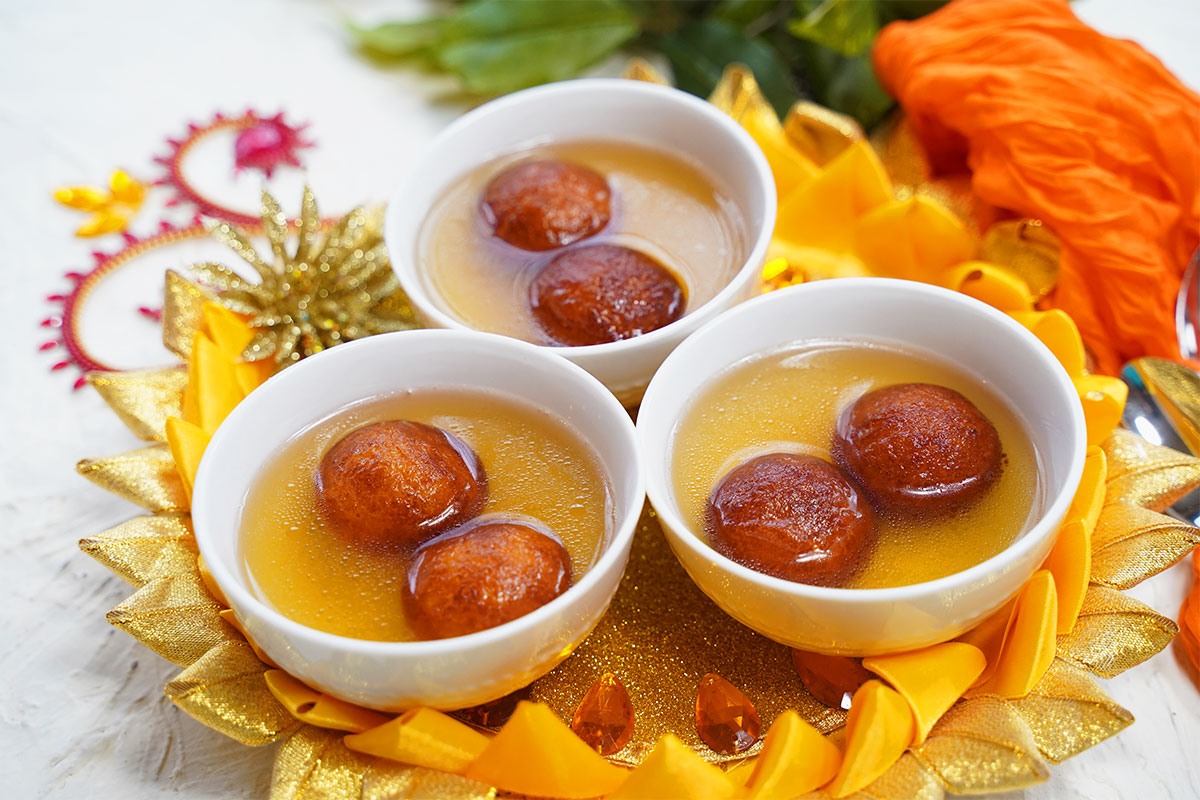Gulab Jamun
Gulab Jamun is soft, delicate, and sweet balls that are soaked in sugar syrup. This is one of the most common Indian desserts that everyone loves to have during special occasions and festivals. Gulab jamuns are popular in Indian weddings and ceremonies!
There are probably more than 50 variations of how to make gulab jamuns. Each recipe is different. Traditional gulab jamuns use khoya (Khoya, also known as mawa or khoa, is dried evaporated milk solids). The milk is slowly simmered in a large iron Kadai (pot) till all its moisture evaporates and reduces to solids. We also get ready khoya in stores. Rose syrup is used to flavor the sugar syrup. I plan to write about a few other varieties at a later date. But, for now, I have a straightforward and foolproof method to share!
I came with an easy recipe that did not use khoya or rose water but still tasted just like the gulab jamuns made on special occasions back home. The unavailability of ingredients made me use the most commonly available ingredients in any store, like milk powder, all-purpose flour, and butter. I bet you will not be disappointed with this recipe as it tastes as good as those traditional gulab jamuns or even better!
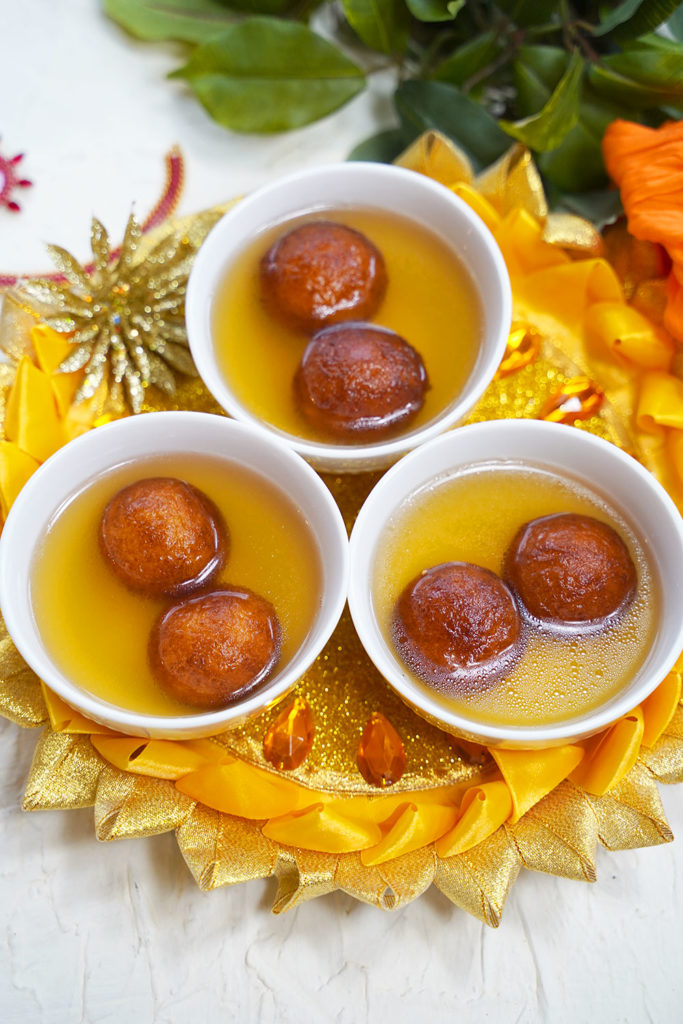
Ingredients, Alternatives, and Tips:
Milk Powder: Milk powder is the main ingredient of this recipe. It is readily available in grocery stores. Make sure to use the room temperature milk powder stored in an airtight container or airtight bag. Do not refrigerate the milk powder. The temperature of the ingredients is critical in making gulab jamuns.
Butter: Butter should be room temperature and soft. If you have refrigerated butter, place it on the kitchen counter for at least 2 hours and then use it. Do not try to thaw the butter in the microwave as it partially melts and alters the consistency and texture of Gulab jamuns.
All-purpose flour: In this recipe, I have used all-purpose flour, but I have tried using gluten-free flour (cup 4 cup brand), and it comes out great.
Baking Powder: The purpose of the baking powder in this recipe is to make the Jamun double in size and absorb the sugar syrup well. The quantity of the baking powder should be precise to avoid the Jamun getting too big and breaking apart.
Milk: Use whole milk if possible. Milk should be lukewarm. It should not be too cold or too warm. If taking the milk out from the refrigerator, microwave for 12 to 20 seconds and set it aside. In this recipe, I have said 4 Tbsp. Add 1 Tbsp if needed while mixing the dough. The amount of milk required to make a dough depends on the quality of the milk powder, room temperature, and the weather outside. I have noticed that I need less milk in the summers to mix and more in the winters. Do not add all the milk at once. Add 1 Tbsp at a time so that you know when to stop adding milk.
Saffron thread and rose water: These are optional ingredients to add to the sugar syrup. I have not used this recipe.
Sugar: It has to be white granulated sugar. Brown sugar does not work.
Cardamom: Even though it is just used for flavoring, do not miss this ingredient. Cardamom gives this dish a unique flavor.
Oil for frying: Traditionally, ghee is preferred for frying. In this recipe, I have used extra light olive oil (neutral-flavored olive oil). Suppose you are not using ghee; neutral oil works the best. Some of the neutral oils are canola oil, vegetable oil, safflower oil. Avoid using oil with a high smoking point or is heavily flavored (sesame oil, extra virgin olive oil, corn oil, avocado oil, peanut oil, etc.).
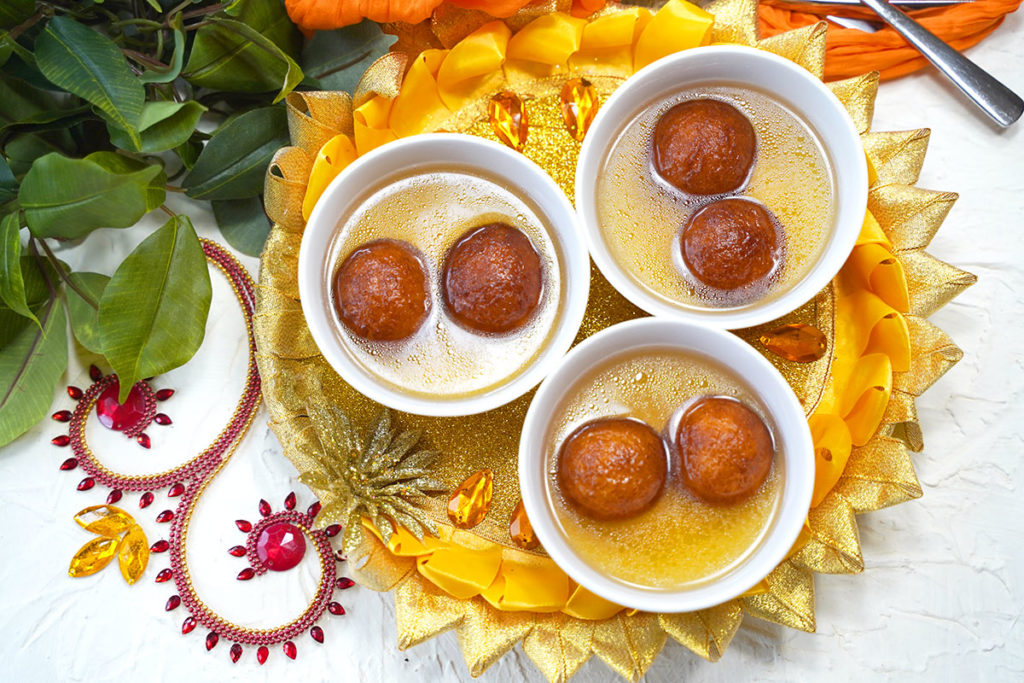
Details of the Recipe Ingredients:
- Try to use the best quality milk powder that is available to you. I have tried this recipe with a few varieties of milk powder, and I have noticed the difference in taste. Nestle is what I most commonly use. Farm fresh brand or any other brand made that is A2 organic works the best.
2. One of the rules I follow with baking powder is to buy the smallest box possible to keep replacing it every six months. Baking powder loses freshness over time once you open the box.
3. Measure all the ingredients correctly, just like how you would make a cake. Altering the recipe might not get good results.
4. Do not knead the dough as it can harden the jamuns. Mix it just enough to form smooth round balls. The main goal is to get balls without any cracks. The cracks on the Jamun can absorb more oil while frying and may split as soon as we add it to frying or the sugar syrup. Divide the dough into 15 equal parts and make balls immediately after completing the dough. If it is left for a longer time, it will dry out, and you may not get good results. If the dough dries out for some reason, slowly add a little milk at a time and try to fix the consistency.
5. Getting the proper consistency of sugar syrup is the trick. Jamun will not absorb the sugar if the syrup is set to boil for a long time. Roughly it takes about 10 minutes of boil time for the water and sugar. Sugar syrup should be sticky (10 minutes of boiling) and should not have a string appearance (20 minutes of boiling). If the sugar syrup is boiled for a very long time, the jamuns will not absorb the dense sugar syrup when soaked.
6. The temperature of the oil in frying the jamuns also plays a key role. The setting I use to make gulab jamuns is low to medium flame. It should take approximately 8 minutes to finish frying the jamuns on both sides and get a deep brown color. When we use a higher setting, the oil will be boiling and cooked on the outside fast, and the inside part will be raw. When a lower temperature setting is used, the oil is not very hot, and it will absorb more oil and turn soggy.
7. The dough should hold together to make smooth balls. If the dough is crumbly, then it means that it is dry and needs a little more milk to mix. If the dough looks too sticky and soggy, add 2 Tbsp of milk powder and try blending it. If it still does not get fixed, add Tbsp of milk powder. It is easy to adjust the consistency and make it work! Don’t expect to get the dough like how you would while making bread. Break dough will have a lot of gluten and be easy to work with to make balls. This dough mainly consists of milk powder and significantly less gluten. So it is okay not to get smooth pliable balls. The recipe is a success if you can make round Jamun balls of the same size without any cracks.
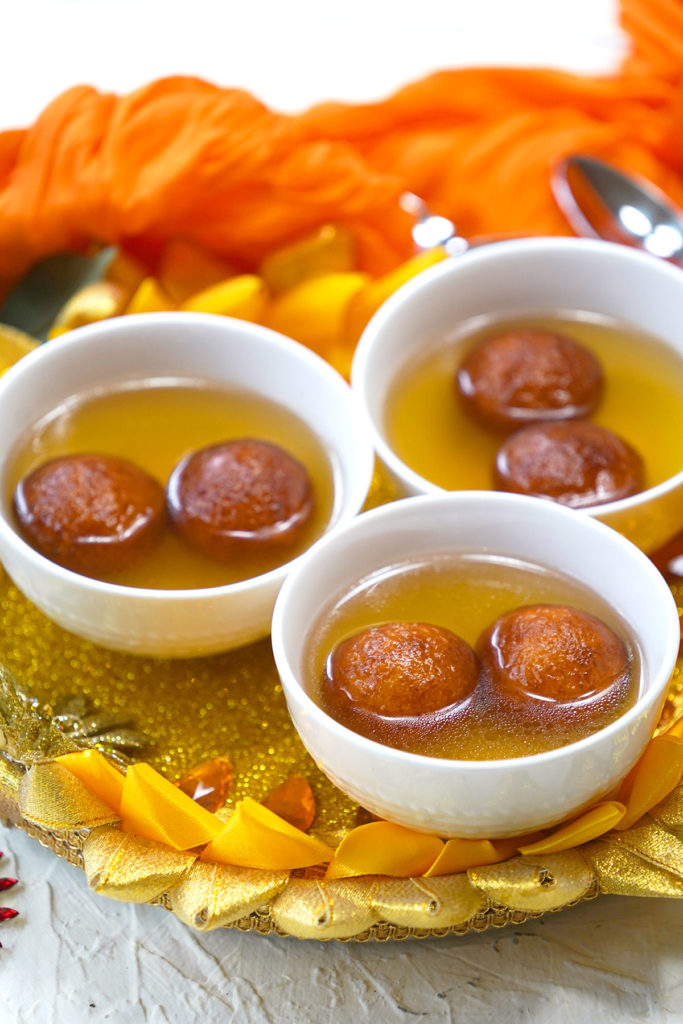
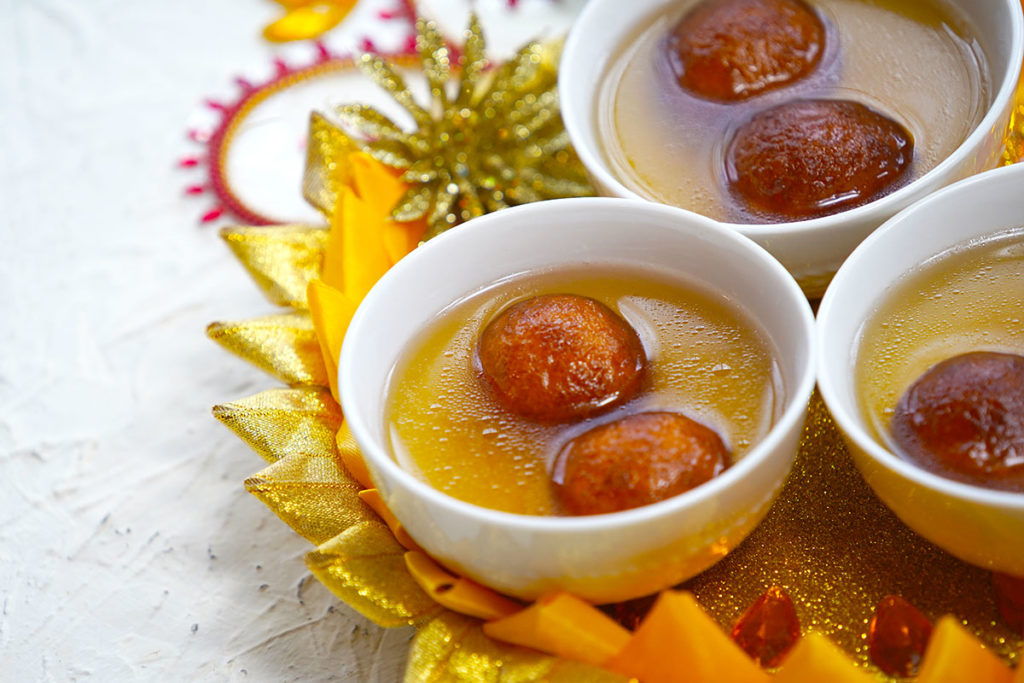
Gulab Jamun Process Instructions:
In a mixing bowl, take 1 1 /4 cup of milk powder (Nestle), 1/4 cup of all-purpose flour, 1/2 tsp baking powder, 2 1/2 Tbsp butter (room temperature), 4 + 1 Tbsp milk (if needed). Mix everything gently to make a smooth dough. Do not knead it.
Do not let the dough sit for a long time. Make 15 small balls and set them aside.
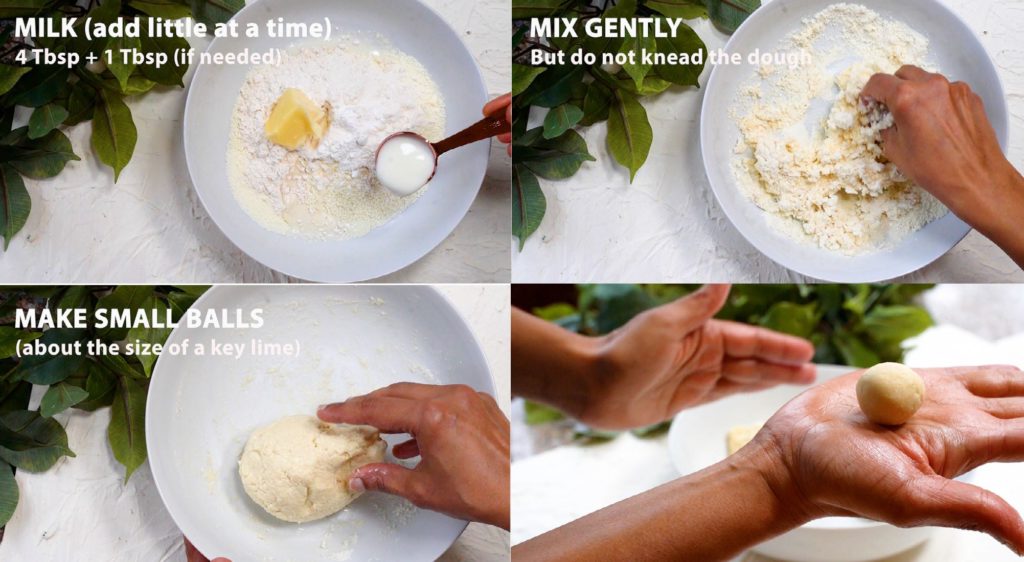
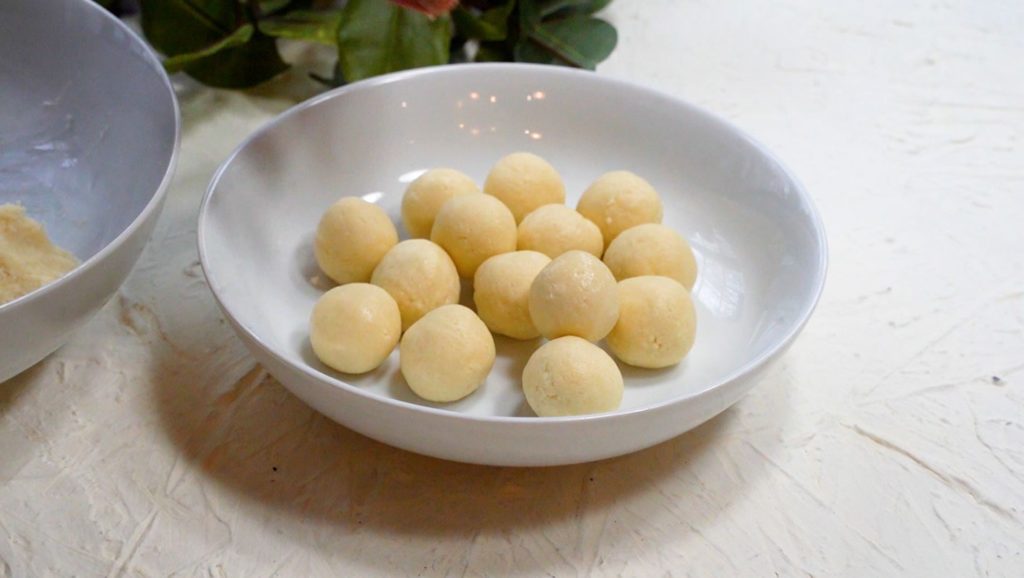
Heat oil in a pan on low to medium heat and fry the jamuns for 8 minutes. Do not fry it at a high setting (it will cook outside fast and not inside) or a low setting ( Jamun cracks and becomes soggy).
Drain the fried Jamun balls on a paper towel.
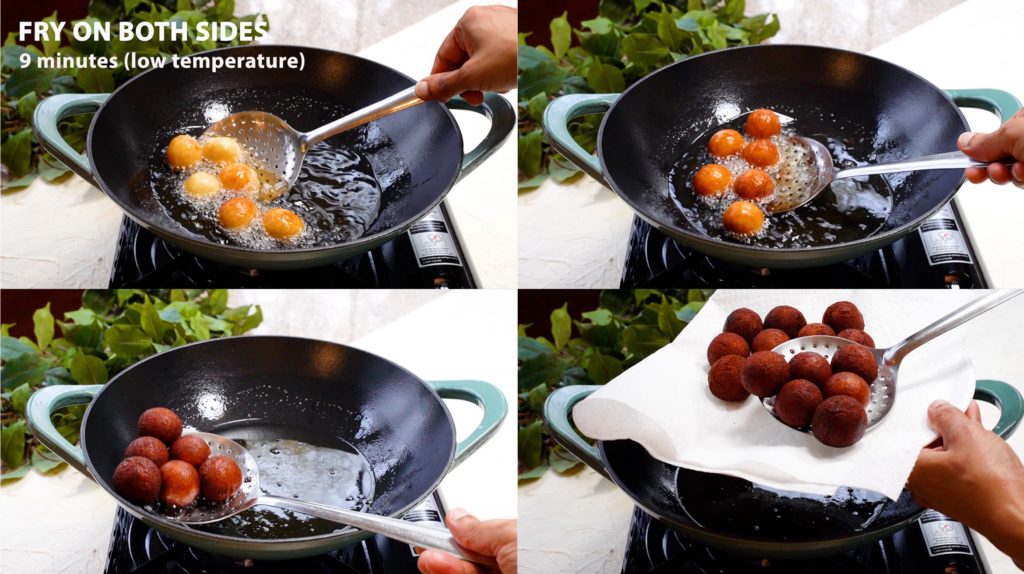
In a 5 quart pan, take 2 1/2 cups of water and set it to boil on a very high flame. Add 3/4th cup of sugar. Sugar dissolves in 5 minutes. Add 5 to 6 peeled cardamom pods to the water and boil for another 10 minutes.
Drain the sugar syrup to a different pot to ensure that the cardamom is not leftover in the sugar syrup.
The sugar syrup must be sticky consistency to soak the Jamun ideally. Do not overboil it to get to the stringy texture. When the sugar syrup becomes too thick and wiry, Jamun will not absorb the syrup.
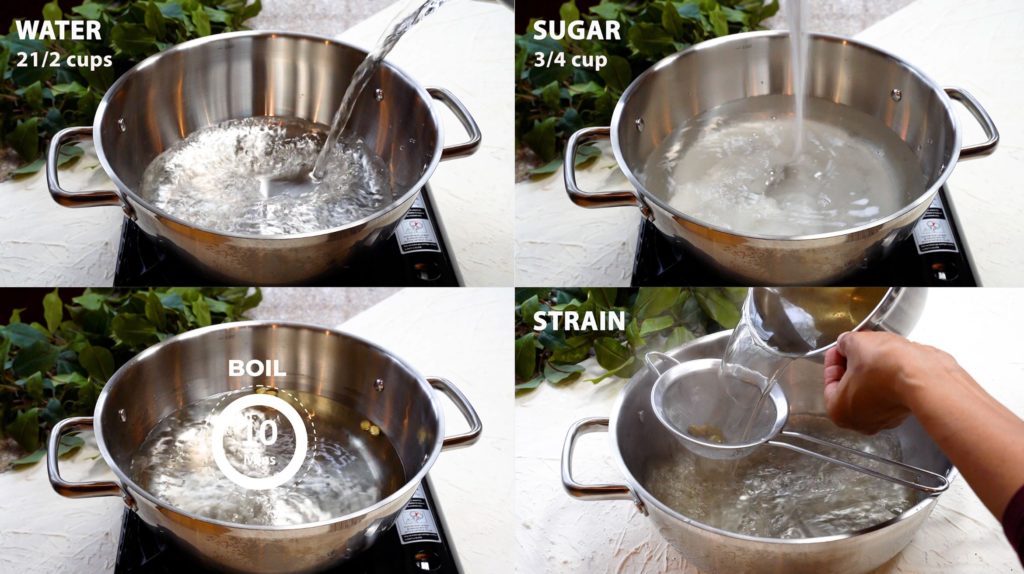
Do not wait for the sugar syrup to cool down to add Jamun. Add it when it is still hot.
Add the fried Gulab Jamun to the strained sugar syrup and let it soak for at least 30 minutes. Gulab Jamuns almost doubles in size after soaking in the syrup.
Serve hot or cold. Trust me; it tastes good either way.
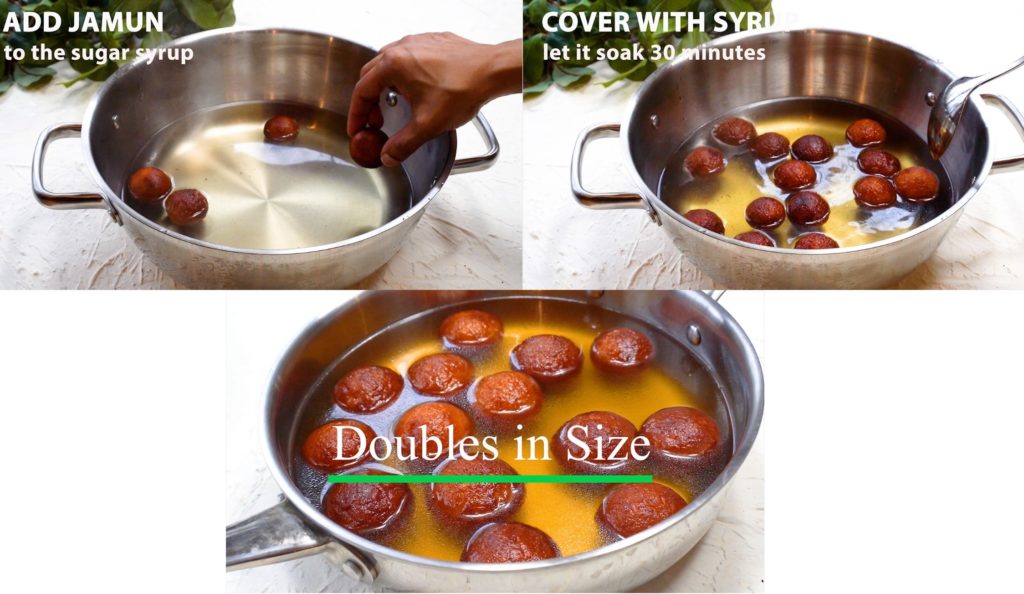
Serving Suggestions:
- Serve hot or cold. Trust me, and it tastes good either way. My favorite way of having Gulab Jamun is to have very hot Jamun with ice cream.
- YOu can also serve this with other Indian desserts like carrot halwa (a dessert made from shredded carrots and milk) and kheer (Indian pudding with rice or semolina).
Storage Instructions for Gulab Jamun:
- Gulab jamuns store well at room temperature for two days. If you live in a tropical or sunny weather climate, it is better to keep these in the refrigerator after the day of making. For bigger parties, it can be made one day ahead of time.
- It can stay fresh in the fridge for two to three days. Thaw for 30 minutes and warm it up on a very low flame for 5 minutes before serving or microwave for 30 seconds.
- If making these for big parties, it is okay to directly transfer the jamuns from the refrigerator to a chafing dish with a low flame.
- I am not sure about the freeing option as I have never tried freezing it. Please let me know in the comments if you ever try!
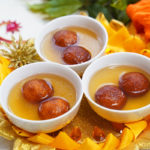
Gulab Jamun
- Total Time: 25 minutes
- Yield: 15 servings
Description
Gulab Jamun is soft, delicate, and sweet balls that are soaked in sugar syrup. This is one of the most common Indian desserts that everyone loves to have during special occasions and festivals. Gulab jamuns are popular in Indian weddings and ceremonies!
I came with an easy recipe that did not use khoya or rose water but still tasted just like the gulab jamuns made on special occasions back home. The unavailability of ingredients made me use the most commonly available ingredients in any store, like milk powder, all-purpose flour, and butter. I bet you will not be disappointed with this recipe as it tastes as good as those traditional gulab jamuns or even better!
Ingredients
Nestle Milk powder- 1 1/4 cup
All-Purpose Flour- 1/4 cup
Baking Powder- 1/2 tsp
Room Temperature Butter- 2 1/2 Tbsp (soft but not melted)
Lukewarm Milk- 4 + 1 Tbsp (adding 1 Tbsp at a time while making the balls)
Sugar Syrup:
Water- 2 1/2 cups
White granulated sugar- 3/4 cup
Few strands saffron threads and rose water (optional)
Instructions
1. In a mixing bowl, take 1 1 /4 cup of milk powder (Nestle), 1/4 cup of all-purpose flour, 1/2 tsp baking powder, 2 1/2 Tbsp butter (room temperature), 4 + 1 Tbsp milk (if needed). Mix everything gently to make a smooth dough. Do not knead it.
2. Do not let the dough sit for a long time. Make 15 small balls and set them aside.
3. Heat oil in a pan on low to medium heat and fry the jamuns for 8 minutes. Do not fry it at a high setting (it will cook outside fast and not inside) or a low setting ( Jamun cracks and becomes soggy).
4. Drain the fried Jamun balls on a paper towel.
5. In a 5-quart pan, take 2 1/2 cups of water and set it to boil on a very high flame. Add 3/4th cup of sugar. Sugar dissolves in 5 minutes. Add 5 to 6 peeled cardamom pods to the water and boil for another 10 minutes.
6. Drain the sugar syrup to a different pot to ensure that the cardamom is not leftover in the sugar syrup.
7. The sugar syrup must be sticky consistency to soak the Jamun ideally. Do not overboil it to get to the stringy texture. When the sugar syrup becomes too thick and wiry, Jamun will not absorb the syrup. Do not wait for the sugar syrup to cool down to add Jamun. Add it when it is still hot.
8. Add the fried Gulab Jamun to the strained sugar syrup and let it soak for at least 30 minutes. Gulab Jamuns almost doubles in size after soaking in the syrup.
9. Serve hot or cold. It tastes good either way.
- Prep Time: 10 minutes
- Cook Time: 15 minutes
- Category: Desserts
- Method: Cook
- Cuisine: Indian
Nutrition
- Serving Size: 1 Jamun
- Calories: 110 kcal
- Sugar: 19.89 g
- Sodium: 78 mg
- Fat: 2.23 g
- Saturated Fat: 1.382 g
- Unsaturated Fat: 0.091 g
- Trans Fat: 0.003 g
- Carbohydrates: 22.88 g
- Fiber: 0.1 g
- Protein: 0.36 g
- Cholesterol: 6 mg
Keywords: Gulab Jamun, Indian Dessert, Jamuns, Easy Gulab Jamuns, Instant powder gulab jamuns, milk powder jamun, instant homemade mix
